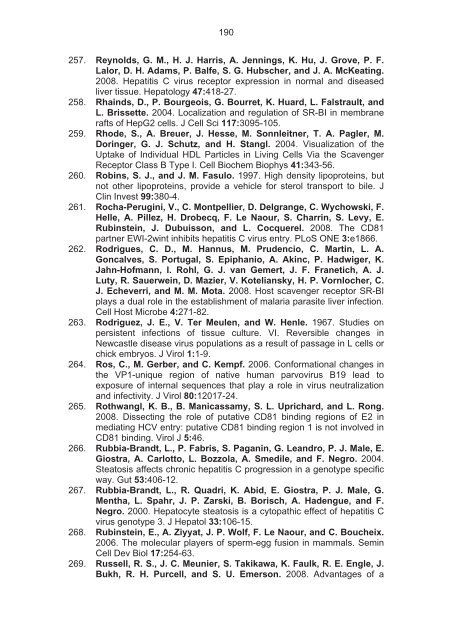The role of scavenger receptor BI in hepatitis - eTheses Repository ...
The role of scavenger receptor BI in hepatitis - eTheses Repository ...
The role of scavenger receptor BI in hepatitis - eTheses Repository ...
You also want an ePaper? Increase the reach of your titles
YUMPU automatically turns print PDFs into web optimized ePapers that Google loves.
190<br />
257. Reynolds, G. M., H. J. Harris, A. Jenn<strong>in</strong>gs, K. Hu, J. Grove, P. F.<br />
Lalor, D. H. Adams, P. Balfe, S. G. Hubscher, and J. A. McKeat<strong>in</strong>g.<br />
2008. Hepatitis C virus <strong>receptor</strong> expression <strong>in</strong> normal and diseased<br />
liver tissue. Hepatology 47:418-27.<br />
258. Rha<strong>in</strong>ds, D., P. Bourgeois, G. Bourret, K. Huard, L. Falstrault, and<br />
L. Brissette. 2004. Localization and regulation <strong>of</strong> SR-<strong>BI</strong> <strong>in</strong> membrane<br />
rafts <strong>of</strong> HepG2 cells. J Cell Sci 117:3095-105.<br />
259. Rhode, S., A. Breuer, J. Hesse, M. Sonnleitner, T. A. Pagler, M.<br />
Dor<strong>in</strong>ger, G. J. Schutz, and H. Stangl. 2004. Visualization <strong>of</strong> the<br />
Uptake <strong>of</strong> Individual HDL Particles <strong>in</strong> Liv<strong>in</strong>g Cells Via the Scavenger<br />
Receptor Class B Type I. Cell Biochem Biophys 41:343-56.<br />
260. Rob<strong>in</strong>s, S. J., and J. M. Fasulo. 1997. High density lipoprote<strong>in</strong>s, but<br />
not other lipoprote<strong>in</strong>s, provide a vehicle for sterol transport to bile. J<br />
Cl<strong>in</strong> Invest 99:380-4.<br />
261. Rocha-Perug<strong>in</strong>i, V., C. Montpellier, D. Delgrange, C. Wychowski, F.<br />
Helle, A. Pillez, H. Drobecq, F. Le Naour, S. Charr<strong>in</strong>, S. Levy, E.<br />
Rub<strong>in</strong>ste<strong>in</strong>, J. Dubuisson, and L. Cocquerel. 2008. <strong>The</strong> CD81<br />
partner EWI-2w<strong>in</strong>t <strong>in</strong>hibits <strong>hepatitis</strong> C virus entry. PLoS ONE 3:e1866.<br />
262. Rodrigues, C. D., M. Hannus, M. Prudencio, C. Mart<strong>in</strong>, L. A.<br />
Goncalves, S. Portugal, S. Epiphanio, A. Ak<strong>in</strong>c, P. Hadwiger, K.<br />
Jahn-H<strong>of</strong>mann, I. Rohl, G. J. van Gemert, J. F. Franetich, A. J.<br />
Luty, R. Sauerwe<strong>in</strong>, D. Mazier, V. Koteliansky, H. P. Vornlocher, C.<br />
J. Echeverri, and M. M. Mota. 2008. Host <strong>scavenger</strong> <strong>receptor</strong> SR-<strong>BI</strong><br />
plays a dual <strong>role</strong> <strong>in</strong> the establishment <strong>of</strong> malaria parasite liver <strong>in</strong>fection.<br />
Cell Host Microbe 4:271-82.<br />
263. Rodriguez, J. E., V. Ter Meulen, and W. Henle. 1967. Studies on<br />
persistent <strong>in</strong>fections <strong>of</strong> tissue culture. VI. Reversible changes <strong>in</strong><br />
Newcastle disease virus populations as a result <strong>of</strong> passage <strong>in</strong> L cells or<br />
chick embryos. J Virol 1:1-9.<br />
264. Ros, C., M. Gerber, and C. Kempf. 2006. Conformational changes <strong>in</strong><br />
the VP1-unique region <strong>of</strong> native human parvovirus B19 lead to<br />
exposure <strong>of</strong> <strong>in</strong>ternal sequences that play a <strong>role</strong> <strong>in</strong> virus neutralization<br />
and <strong>in</strong>fectivity. J Virol 80:12017-24.<br />
265. Rothwangl, K. B., B. Manicassamy, S. L. Uprichard, and L. Rong.<br />
2008. Dissect<strong>in</strong>g the <strong>role</strong> <strong>of</strong> putative CD81 b<strong>in</strong>d<strong>in</strong>g regions <strong>of</strong> E2 <strong>in</strong><br />
mediat<strong>in</strong>g HCV entry: putative CD81 b<strong>in</strong>d<strong>in</strong>g region 1 is not <strong>in</strong>volved <strong>in</strong><br />
CD81 b<strong>in</strong>d<strong>in</strong>g. Virol J 5:46.<br />
266. Rubbia-Brandt, L., P. Fabris, S. Pagan<strong>in</strong>, G. Leandro, P. J. Male, E.<br />
Giostra, A. Carlotto, L. Bozzola, A. Smedile, and F. Negro. 2004.<br />
Steatosis affects chronic <strong>hepatitis</strong> C progression <strong>in</strong> a genotype specific<br />
way. Gut 53:406-12.<br />
267. Rubbia-Brandt, L., R. Quadri, K. Abid, E. Giostra, P. J. Male, G.<br />
Mentha, L. Spahr, J. P. Zarski, B. Borisch, A. Hadengue, and F.<br />
Negro. 2000. Hepatocyte steatosis is a cytopathic effect <strong>of</strong> <strong>hepatitis</strong> C<br />
virus genotype 3. J Hepatol 33:106-15.<br />
268. Rub<strong>in</strong>ste<strong>in</strong>, E., A. Ziyyat, J. P. Wolf, F. Le Naour, and C. Boucheix.<br />
2006. <strong>The</strong> molecular players <strong>of</strong> sperm-egg fusion <strong>in</strong> mammals. Sem<strong>in</strong><br />
Cell Dev Biol 17:254-63.<br />
269. Russell, R. S., J. C. Meunier, S. Takikawa, K. Faulk, R. E. Engle, J.<br />
Bukh, R. H. Purcell, and S. U. Emerson. 2008. Advantages <strong>of</strong> a

















